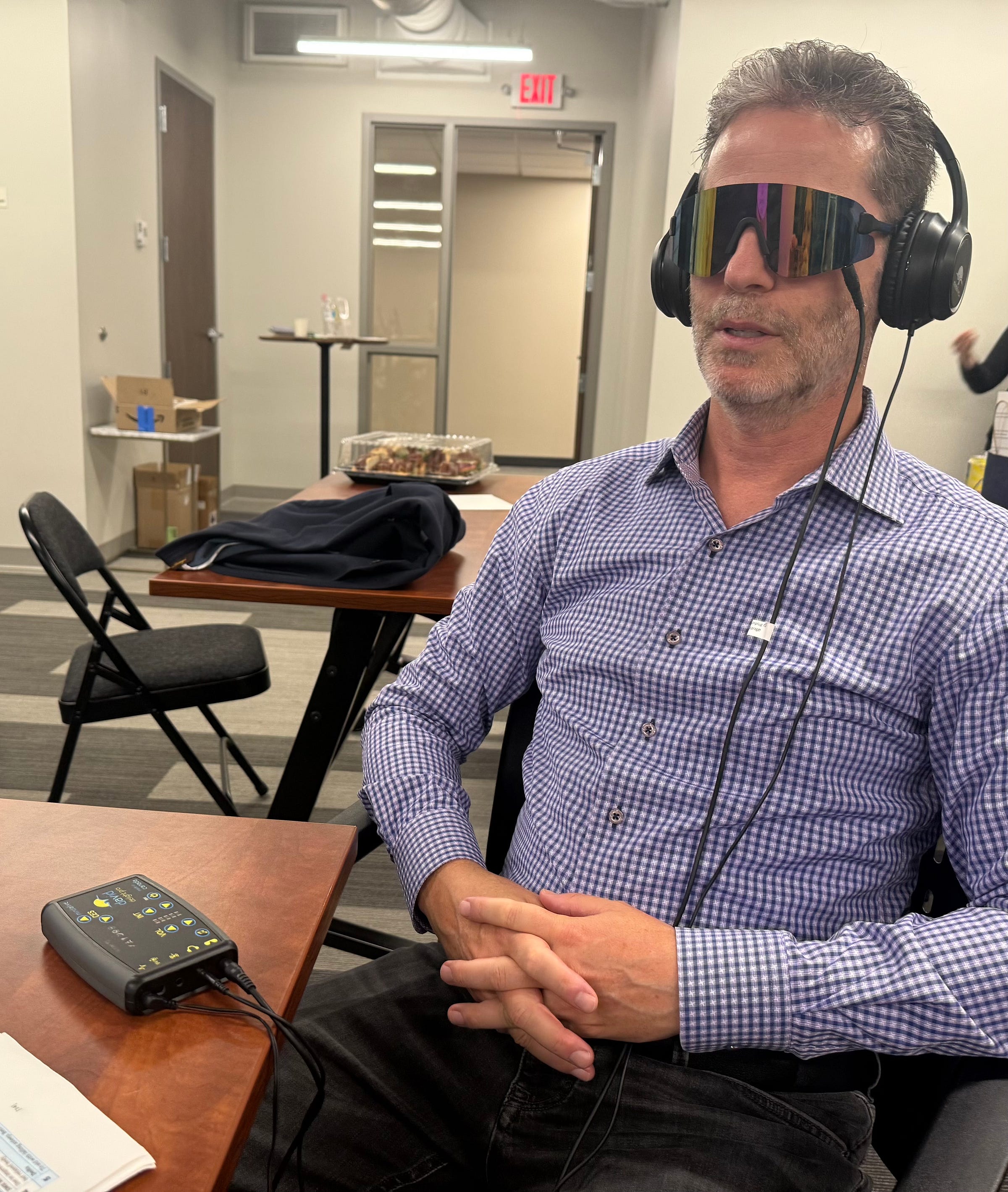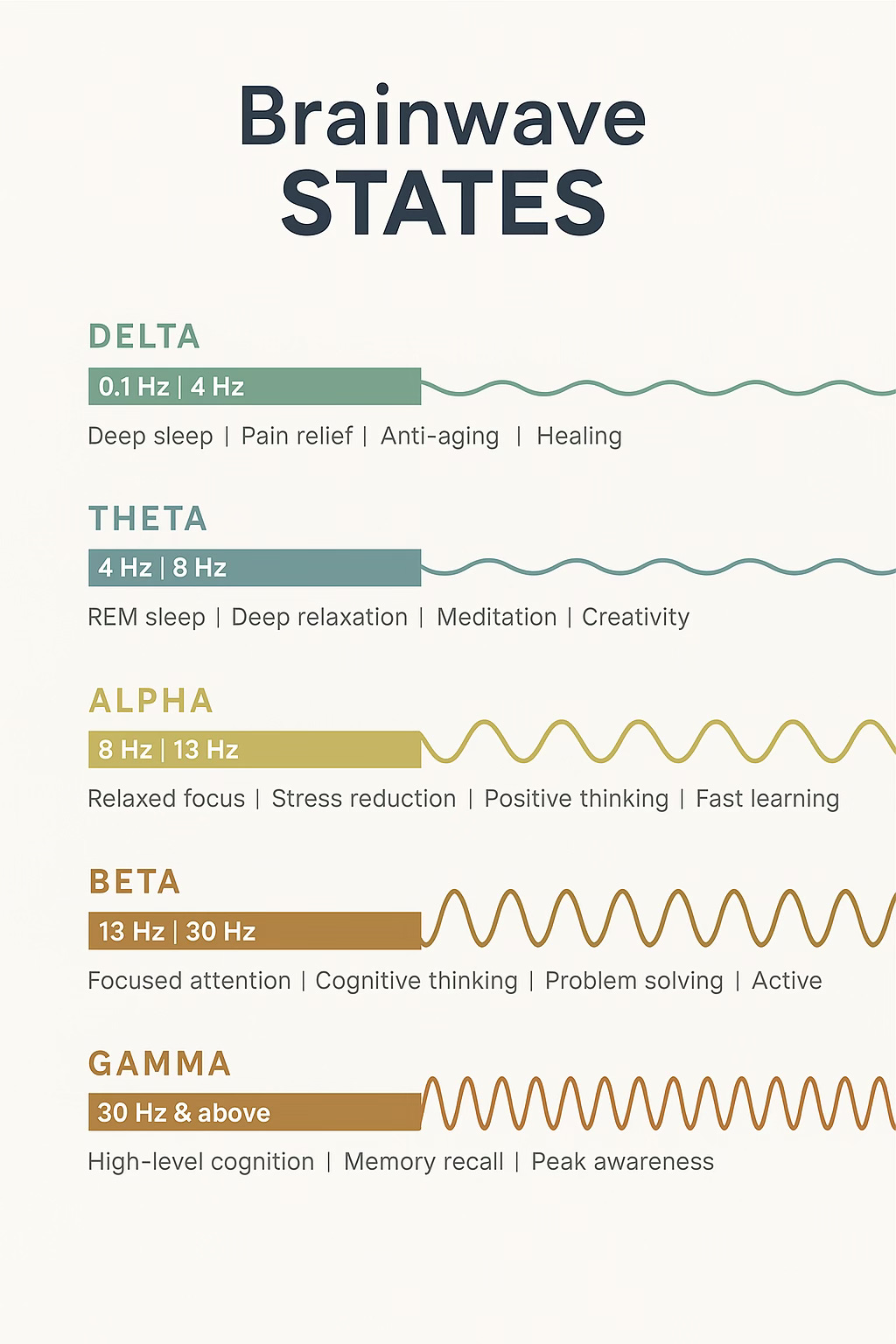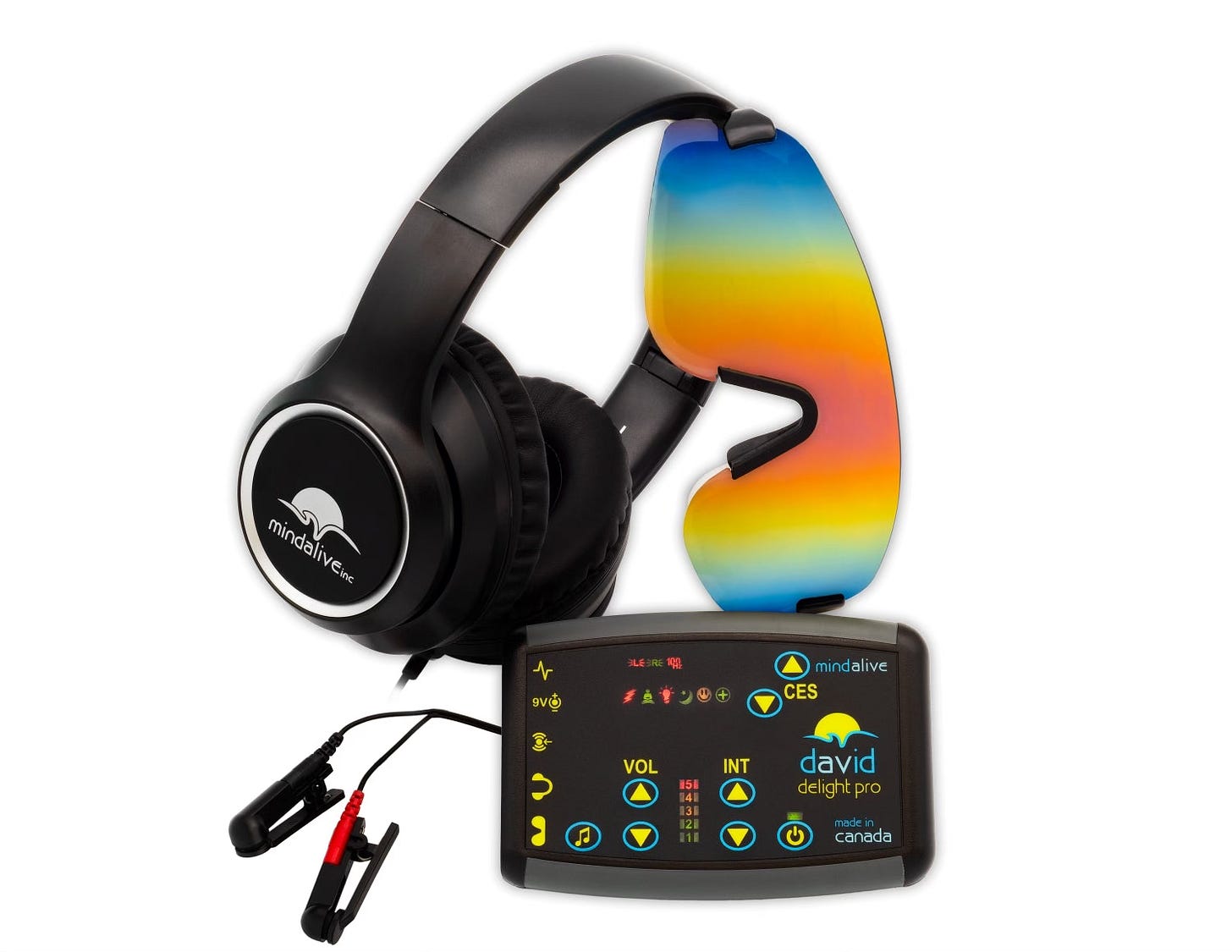I’m always looking for practical tools that might help keep my brain sharp as I get older—especially given my family history of Alzheimer’s disease. So when I came across a technology that claims to affect brainwave patterns using light and sound, I was intrigued. Skeptical, but intrigued.
A few nights ago I had the chance to try this technology. It’s called audio-visual entrainment (AVE), and although you likely haven’t heard of this before, there’s growing scientific interest in how this non-invasive technique might support mood, sleep, attention, and even memory.
I only tried it for a few minutes so I could get a sense of what it was like. A few minutes was enough to pique my interest, however, so I decided to learn more about brainwaves and AVE.
My bottom line is this: AVE isn’t a miracle cure, and it’s definitely not a replacement for foundational lifestyle habits like exercise and good sleep. But it might be another low-risk, high-upside tool for some people, and for that reason, it’s worth exploring adding it to your brain health toolbox.
What Is Audio-Visual Entrainment?
Audio-Visual Entrainment, or AVE, is a non-invasive technique that uses rhythmic light and sound pulses to influence the brain’s natural rhythms. These pulses are delivered through goggles equipped with LEDs and headphones that emit audio tones. The idea is simple but powerful: the brain tends to synchronize—or “entrain”—its own electrical activity to external rhythms. This phenomenon is known as the frequency-following response.
For example, if you listen to a rhythmic pulsing sound at 10 Hz (ten pulses per second), your brainwaves may begin to mirror that rhythm. The same goes for visual flickers. Over time, this external rhythm can lead to changes in the dominant brainwave patterns, guiding the brain into a desired mental state. Practitioners use AVE to promote relaxation, focus, deep sleep, or even cognitive stimulation, depending on the frequencies used.
To put this in context: your brain operates at different frequencies depending on your mental state. When you’re in deep sleep, your brain is dominated by slow delta waves. When you’re focused and alert, faster beta waves are more prominent. If you’re in a meditative or creative state, you’re likely experiencing more theta or alpha activity. AVE taps into this natural rhythm system and offers a way to gently steer the brain toward certain states—without drugs, stimulants, or sleep aids.
Some AVE sessions aim for calm and relaxation (using alpha or theta frequencies), while others are designed for wakeful focus (using beta or sensorimotor rhythm, or SMR, in the 12-15 Hz range). More experimental programs target gamma frequencies, which may support memory and cognitive integration—especially intriguing for those interested in brain aging and dementia prevention.
Why Brainwave Modulation May Matter
We often think of brain aging in terms of memory loss, but behind that are subtle shifts in the brain’s electrical rhythms. As we age, brainwave activity tends to become less dynamic and less well-regulated. Studies have shown that older adults often experience decreases in alpha and gamma activity, both of which are associated with attentiveness, learning, and memory integration. At the same time, there’s often an increase in slower-wave activity like theta and delta during the day, which can contribute to mental fog and fatigue.
This is where AVE may offer value. By gently nudging the brain toward healthier oscillatory patterns, AVE could help restore a better balance between fast and slow brainwaves. That, in turn, may improve attention, alertness, sleep quality, and even mood. It’s not about overpowering the brain’s natural rhythms—rather, it’s about guiding them, like tapping a metronome to help a musician stay on beat.
Even more compelling is AVE’s potential role in neuroplasticity—the brain’s ability to adapt, learn, and rewire itself. Several mechanisms may be at play here. Repeated AVE sessions may strengthen the synchrony between brain regions, a key aspect of healthy cognition. Some researchers also believe AVE may promote long-term potentiation (LTP), the cellular process behind memory formation. There are even hints that entrainment may enhance levels of brain-derived neurotrophic factor (BDNF), a protein critical to brain resilience and plasticity—although nothing like what a good workout would achieve. Again, consider AVE to be a complementary add-on to solid lifestyle choices.
Although more research is needed, these early insights suggest that AVE may be especially beneficial in midlife and later life—precisely when the brain’s natural rhythms and adaptability tend to decline.
A Closer Look at the DAVID Delight Pro
One of the most respected and widely used AVE systems available today is the DAVID Delight Pro, developed by Mind Alive, Inc. Mind Alive has been selling AVE devices since 1984. The DAVID Delight Pro is the device I used a few nights ago—which is why I’m highlighting it here. I have no affiliation with the company; I just chose this model as a real-world example.
What sets this device apart is its combination of flexibility, scientific grounding, and dual functionality: it offers both audio-visual entrainment and cranio-electro stimulation (CES) in one integrated system.
The DAVID Delight Pro ($560) uses goggles with built-in LEDs to deliver precise visual pulses, usually with your eyes closed. The headphones deliver auditory stimulation—either simple rhythmic tones or more complex audio patterns designed to complement the visual input. You can select from a range of programs, each targeting a specific goal: mental clarity, stress reduction, better sleep, mood stabilization, or improved learning. Each program lasts about 20 to 30 minutes, and most users describe the experience as deeply relaxing.
But the DAVID Delight Pro also includes cranio-electro stimulation, or CES—a feature that delivers gentle, pulsed micro-currents through earlobe clips. CES has been studied since the 1970s and is FDA-cleared in the U.S. for the treatment of insomnia, anxiety, and depression. It’s believed to work by modulating brainwave activity and altering levels of neurotransmitters, like serotonin and dopamine, which are often dysregulated in mood disorders and chronic stress.
In clinical practice, CES is sometimes used on its own, but many AVE users choose to combine CES and audio-visual stimulation for synergistic effects. For example, someone might use CES before bedtime, followed by a delta-wave AVE session to encourage deeper sleep. Or they might combine both to reduce anxiety before a stressful day or calm the nervous system after intense mental work.
Compared to other consumer devices in the neurotech space, the DAVID Delight Pro stands out for being highly customizable while still easy to use. It’s not flashy or gamified, but it’s backed by decades of clinical experience and offers a surprisingly wide range of mental-state training options.
Where AVE and CES Fit in a Brain Health Strategy
AVE and CES aren’t substitutes for the fundamentals of brain health—but they may enhance or reinforce the benefits of what you’re already doing.
Think of AVE like a gentle brain training tool:
After a morning workout, use gamma AVE to support memory consolidation
Before a focused writing session, try SMR (12–15 Hz) entrainment for relaxed alertness
After a long, stressful day, use CES or an alpha-theta program to unwind
Before bed, run a 20-minute delta session to help your brain prepare for deep sleep
The beauty of AVE is that it doesn’t require effort. You don’t have to “perform” or stay focused during the session. You simply sit back and let your brain tune into the rhythm. Over time, regular use may promote healthier baseline brainwave patterns, especially when combined with other proactive habits.
Dangers and Limitations
While AVE and CES are considered safe for most healthy adults, there are some important precautions.
Who should avoid AVE and CES:
People with photosensitive epilepsy
Those with light-triggered migraines
Individuals with pacemakers or electrical implants
People with severe mental illness (unless under clinical supervision)
Possible side effects:
Mild headache or eye strain (usually from too-bright light)
Temporary disorientation or overstimulation, especially from beta or gamma sessions
Emotional release or vivid dreams with deeper theta protocols
Research is still evolving and much of it comes from small studies, some of which are funded by the device manufacturers. We need larger, independent trials to fully validate the benefits. Not everyone responds to AVE and effects can vary widely based on individual brain state, consistency, and context of use, but it may work for you. I’d definitely like to try it out for a month sometime to see what it can do for me.
Final Thoughts: A Gentle Nudge, Not a Magic Wand
AVE and CES aren’t miracle technologies. They won’t undo years of poor lifestyle choices, nor will they single-handedly prevent Alzheimer’s. But they offer a compelling proposition: a safe, non-invasive way to help your brain return to healthier rhythms—something most of us need more of, not less.
They’re especially appealing for those of us in midlife or beyond who want to age with clarity, purpose, and mental resilience. These tools are passive, accessible, and surprisingly affordable compared to many other neurotech gadgets on the market.
A clinician I trust and whose clinic focuses entirely on brain health says that he has helped thousands of clients using AVE. That’s a strong endorsement from someone who has tried a lot of different devices.
AVE devices aren’t the entire toolbox, but they’re tools worth considering—and perhaps even using regularly.
I am not a doctor or healthcare provider. This content is for general informational purposes only and is not intended as a substitute for professional medical advice, diagnosis, or treatment. I do not claim to have expertise in health, medicine, or wellness, and the content shared here should not be used to make decisions about your health or well-being. This information may provide ideas about topics to discuss with your medical team.
Always consult with a qualified healthcare provider for any questions or concerns regarding your health. Do not disregard professional medical advice or delay seeking it based on the information you have read here. Reliance on any information provided here or linked to from here is solely at your own risk.
I make no warranties about the completeness, reliability, or accuracy of the information presented.




As always. Thank you for bringing something to my attention that I didnt know existed. Being an E4 of one allele I am always excited to hear and try new things. Thanks again.